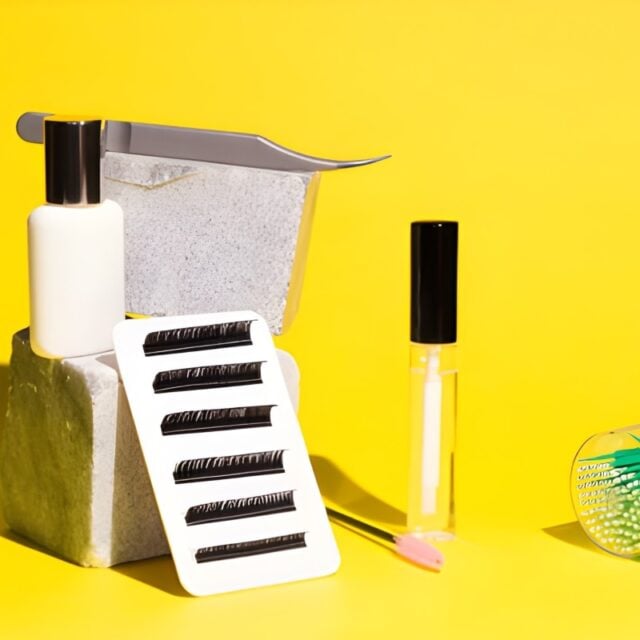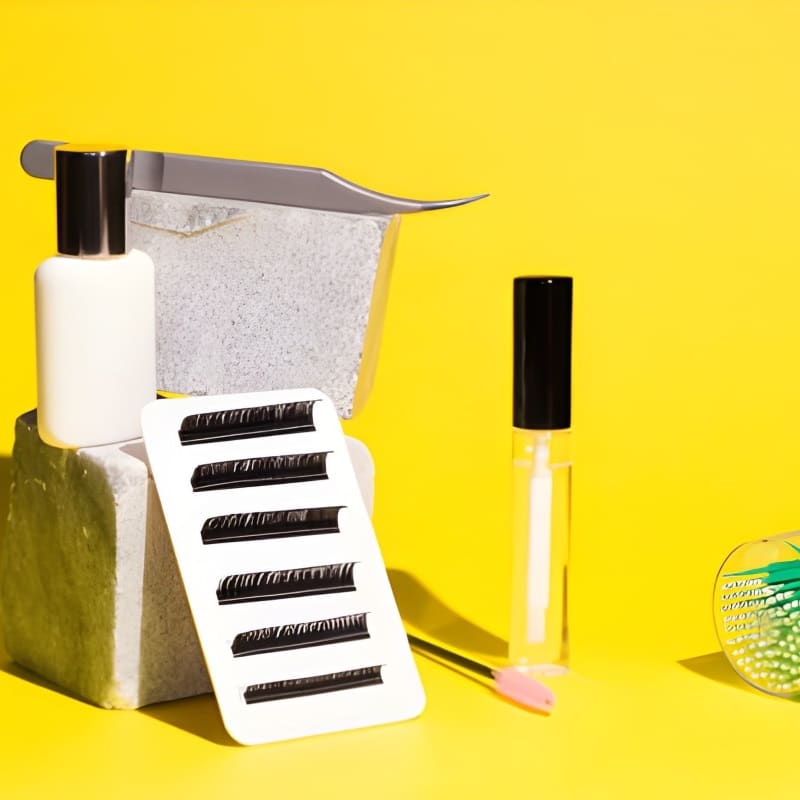
Understanding the Definition of Cosmetic Products
The foundation of lash glue regulation EU begins with the definition of a cosmetic product under Regulation (EC) No. 1223/2009. A cosmetic is defined as any substance or mixture intended to be placed in contact with external parts of the human body for cleaning, perfuming, changing appearance, protecting, or correcting body odors.
This means that a product qualifies as a cosmetic only if its main purpose is aesthetic. Adhesives, however, are fundamentally designed for bonding, not beautifying. Even though they are used in beauty applications, the glue itself does not directly alter the body’s appearance. For example, nail glue only fixes an artificial nail to the natural one, and eyelash adhesive merely attaches extensions. These actions serve a mechanical purpose, not a cosmetic one.
Function vs. Purpose
The difference between function and purpose is at the core of nail glue regulation and lash glue regulation EU. A cosmetic product serves a purpose that directly improves appearance or beauty. Conversely, adhesives serve as auxiliary products; they facilitate the beautification process but do not carry it out on their own. This principle is frequently cited by authorities when determining whether eyelash adhesives are cosmetics. The answer is always in the affirmative. Usually, the answer is no, as their main purpose is adhesion rather than aesthetic improvement.
Product presentation and claims also have a big impact on classification. Regulators may evaluate a label or marketing material differently if it emphasizes “beautifying” or “cosmetic” qualities, such as “makes lashes look fuller” or “improves lash appearance.” However, the EU’s lash glue regulation classifies it as a chemical adhesive rather than a cosmetic when the packaging emphasizes bonding strength or durability.
The Role of the EU Borderline Manual
The European Commission periodically releases the Manual on Borderline and Classification for Cosmetic Products to address ambiguities like these. When a product’s cosmetic status is unclear, this document assists manufacturers and national authorities in interpreting borderline cases.
The 2024 update to the Borderline Manual brought clarity to nail glue regulation and lash glue regulation EU by explicitly listing false eyelash and nail adhesives among products often mistaken for cosmetics. According to the handbook, a product should not be categorized as a cosmetic even if it indirectly contributes to an aesthetic outcome if its main purpose is to “bond or attach materials.” This addition resolved long-standing ambiguity and aligned interpretations across EU Member States.
Nevertheless, borderline evaluations must still consider composition and marketing. Authorities may classify an adhesive as cosmetic on a case-by-case basis if it contains ingredients that have conditioning or beautifying properties or if its claims suggest cosmetic performance. This flexibility guarantees that goods that are genuinely intended for cosmetic use, as opposed to those that are merely mechanically bonded, are properly supervised under the Cosmetics Regulation.
Why Most Lash and Nail Glues Are Not Cosmetics
Most national competent authorities, including those in France and Germany, have ruled that are eyelash adhesives cosmetics should be answered negatively. These goods are typically regarded as chemical adhesives and are therefore governed by CLP (Classification, Labeling, and Packaging) and REACH (Registration, Evaluation, Authorization, and Restriction of Chemicals) regulations.
The logic is consistent: classification is decided by the primary function test. Since nail glue regulations classify these products as adhesives used for bonding, they are not covered by the cosmetics category, which focuses on altering appearance. In other words, it is the false nail or lash that adds beauty, not the glue itself.
The distinction is significant from a regulatory perspective since chemical products need to provide Safety Data Sheets (SDS) and hazard labeling, whereas cosmetics need special documentation, such as the Cosmetic Product Safety Report adhesives. Incorrect glue classification could result in enforcement actions, product recalls, or loss of EU market access for manufacturers.
When Adhesives May Be Classified as Cosmetics
Although the majority of adhesives are not considered cosmetics, there are some exceptions to the lash glue regulations EU when the product’s formulation or marketing makes claims about how beautiful it is. A product may be considered a cosmetic if it includes ingredients that condition, color, or noticeably improve natural lashes or nails. For example, if an eyelash adhesive contains nourishing ingredients like keratin or panthenol and claims to “protect your natural lashes,” it serves a cosmetic purpose in addition to adhesion.
In these cases, manufacturers must meet all cosmetic obligations, including preparing a Cosmetic Product Safety Report adhesives, and compiling a Product Information File (PIF) before market entry. This ensures that the product is safe for direct contact with the skin or mucous membranes, and that its ingredients comply with Annex II and Annex III of the Cosmetics Regulation.
Documentation and Compliance Obligations
Cosmetic Product Safety Report (CPSR)
The CPSR is a mandatory scientific evaluation required for all cosmetics sold in the EU. For products falling under nail glue regulation EU or lash glue regulation EU as cosmetics, the safety assessor must analyze the toxicological profiles of every ingredient, expected exposure levels, and potential sensitization risks. Particular attention is given to the eyes and nail bed areas, as both are susceptible to irritation.
A complete Cosmetic Product Safety Report adhesives includes an assessment of raw materials, impurities, and impurities from the packaging. It also evaluates how repeated exposure to cyanoacrylates, solvents, or formaldehyde-releasing agents might affect human health. Without this report, cosmetic adhesives cannot be legally marketed in the EU.
Product Information File (PIF) and Labeling
Brands are required to keep a PIF that includes the complete product description, composition, manufacturing process, safety evaluation, labeling, and claim substantiation in addition to the CPSR. Competent authorities must have easy access to the PIF for a minimum of ten years.
Regulation (EC) No. 1223/2009’s Article 19 must be followed when labeling. This means that the ingredient list, function, batch number, precautions, and name and address of the Responsible Person must all be printed clearly. False statements, like advertising a chemical adhesive as “cosmetic-grade” without supporting evidence, may result in fines or the forced discontinuation of the product.
When Nail and Lash Glues Are Not Cosmetics
A product is subject to general chemical laws if it does not meet cosmetic standards. If so, the EU’s lash glue regulation and nail glue regulation indicate adherence to the REACH and CLP frameworks. Manufacturers are required to make certain that dangerous materials are appropriately registered, marked with the appropriate hazard pictograms, and come with a comprehensive Safety Data Sheet.
Companies are required by REACH to prove that their ingredients are safe for both the environment and human use. Conversely, CLP regulates the use of standard hazard symbols and precautionary statements in chemical products to convey risk. Serious administrative penalties may follow noncompliance with these frameworks.
Furthermore, consumer goods that are not specifically covered by other EU laws are subject to the General Product Safety Regulation (GPSR). Even if a product is not a cosmetic, this regulation guarantees that it is safe for regular, predictable use before it is put on the EU market. As a result, adhesive manufacturers are still required to evaluate risks and give customers sufficient warnings.
Guidance for Manufacturers and Importers
Structured analysis is necessary to navigate the complexities of eyelash adhesive cosmetics. Classification and compliance can be ascertained using the following framework:
- Determine the main purpose of the product. It is not a cosmetic if adhesion is the dominant factor.
- Examine advertising claims. Phrases that imply enhancement, protection, or beautification set off the cosmetic scope.
- Consider the composition. Cosmetic classification is supported by ingredients such as colorants or conditioning agents.
- Examine the safety information. Apply the principles of cosmetic product safety report adhesives when evaluating a product that comes into contact with skin or mucosa.
- Record decisions. Maintain SDS, classification justifications, and internal memos available for review.
It is advised to speak with a regulatory expert in borderline cases. Enforcement risks or duplicate compliance expenses may result from misclassification. To support their classification choice, many manufacturers create both a complete REACH file and a CPSR draft.
Frequently Asked Questions (FAQ)
Q1. Are all eyelash adhesives considered cosmetics?
No. The majority of eyelash glues are regulated by laws governing chemical products. Under the EU’s lash glue regulation, only products that assert or exhibit a beautifying function are considered cosmetics.
Q2. What occurs if my glue is incorrectly categorized?
Misclassification can result in recalls or import restrictions. Authorities may demand a full Cosmetic Product Safety Report adhesives if marketing materials suggest cosmetic use.
Q3. Is CPSR testing necessary for nail glue regulation?
Only if the nail glue is categorized as a cosmetic. The CPSR is not necessary if it is used only as an adhesive, but REACH and CLP requirements still apply.
Q4. Is it possible for a product to be both chemical and cosmetic?
No, a single classification based on the dominant function is required by EU law. Labeling that is hybrid is not allowed.
Q5. For non-cosmetic adhesives, what paperwork is necessary?
Safety Data Sheets, hazard labels, and documentation of REACH registration must be kept up to date by manufacturers. Product safety must be proven, even if it isn’t cosmetic.
Conclusion
In conclusion, nail and lash glues are generally not considered cosmetic products under EU law. Their primary purpose, adhesion, places them outside the scope of Regulation (EC) No. 1223/2009. However, if a product’s formulation or marketing introduces a beautifying effect, it may require full compliance with lash glue regulation EU and preparation of a cosmetic product safety report adhesives.
Understanding how nail glue regulation applies to your products is essential for safe and lawful market placement. Every manufacturer or importer must clearly document their classification reasoning, maintain safety data, and follow updates from the EU Borderline Manual to stay compliant.
If your adhesive product might fall under the cosmetic category or you’re unsure about its classification, it’s best to seek expert guidance before entering the market.
Certified Cosmetics helps manufacturers and brands navigate EU cosmetics compliance with professional CPSR preparation, PIF documentation, and expert regulatory support.

